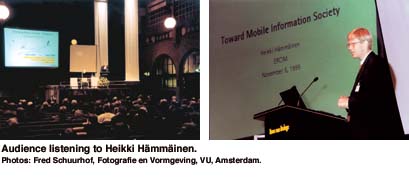Heikki Hämmäinen, Vice-President Nokia Networks
Towards the Mobile Information Society

Nowadays one witnesses the use of devices like laptops for giving presentations, making overhead projectors obsolete, and of mobile ‘gadgets’ combining functions like watch, alarm clock, scheduler, telephone, message receiver, information retriever, etc. Concerning the emerging mobile information society, more important than technology and having a wider impact is the life-style aspect. These mobile devices are really ‘taking over the soul’. The good news is that those devices are certainly doing a good job, the bad news that people become very dependent on them, in particular the younger generation, grown up with those mobile devices.
At present the number of cellular phones is growing much more rapidly than the number of PCs. Whereas nowadays one typically attends a meeting carrying a laptop in your hand and a mobile device for other purposes in your pocket, the last ones will outnumber laptops (as these already outnumber desktops) before long. Turning to the mobile Internet, there are three services insufficiently addressed in the Internet technology so far: location-based, push-type, and personalized profile-based services. The current Internet is about virtual reality, mobile Internet is about real-time applications like information on the time schedule while going to the bus stop. Location-based services is a major new area requiring very difficult technologies, such as satellite-based GPS, triangulation-based technologies, and in-house type of uses where satellite services are not usable. Push-type of services address the real-time character of certain information. Lots of activities are going on in this area, both in the mobile and in the Internet standardization bodies, supporting this evolution. Personalization still has many open questions, mainly coming back to the difficulty of anticipating what people really want. Design of personal profiles, agents analyzing your incoming mail, etc., are being studied already for years, and such problems become even more important in real-time Internet interactions.
Fixed and mobile Web differ in the real-time and the security aspects, as well as some technical aspects, since it has turned out to be difficult to optimize www-type of activities to the mobile environment (complicated radio technology, unreliable transport mechanisms). Because cellular users gradually become Web users as well, the question rises: what are we using our pocket device and our desk/laptop for? Desktop Internet access is often used for browsing and finding information. Use in real life often requires real-time access to that information through mobile devices. It is expected that the ratio mobile/fixed use will dramatically increase as regards the number of sessions.
What will happen technically is much easier to say than how and even more when it happens. Internet will be brought into everyone’s pocket by the Wireless Applications Protocol (WAP), gadgets for it have been brought into market just recently. So this happens fast, using very much the existing network infrastructure. The challenge is to optimize the traffic for Internet-type of use, and therefore GPRS (General-purpose Package Radio Service) will be developed on top of GSM networks, the first deployments being expected next year. These developments enable further fundamental steps like the ‘always-connected’ challenge. At present office PCs and laptops are turned on and off for Internet connection, and it takes some time before the connection is made. Mobile Internet access must be instant. The next generation Internet Protocol IPv6 will enable active addresses for every user, bringing the Internet in your pocket with instant access. It seems possible to stretch the current Internet towards these new types of use, but it is getting more and more expensive. We see that there are enough motivations for the transition to IPv6 even though it causes pain (the present Internet version 4 is 25 years old). The introduction of the third generation cellular networking environment, which is the higher speed wide-area mobile network standard, to be deployed in 2001, will change the perception of what mobile Internet is. The simultaneous evolutions: from the second to third generation cellular networks, in radio technologies, and in the actual Internet layer, form major challenges for the industry.
The transition from virtual reality to real reality Internet takes time, and the fixed tradition in WWW is very strong. Therefore we are pushing hard in the World Wide Web consortium W3C, and by participating there try to activate the mobile aspects.
